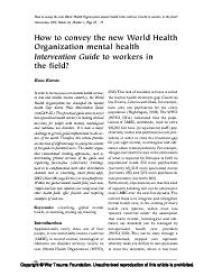How to convey the new World Health Organization mental health Intervention: guide to workers in the field?
In order to increase access to mental health services in low and middle income countries, the World Health Organization has developed the mental health Gap Action Plan Intervention Guide (mhGAP-IG). This practical guide aims to assist non-specialised health workers in making clinical decisions for people with mental, neurological and substance use disorders. It is now a major challenge to get this guide implemented in all corners of the world. Therefore, this article provides an overview of different ways to convey the content of the guide to potential users. The author argues that ‘conventional’ training approaches, such as distributing printed versions of the guide and organising face-to-face (classroom) trainings, need to be complemented with other distribution channels such as e-learning, smart phone apps, SMS (Short Message Service) or voice platforms. Within the global mental health field, such new, simple and low tech solutions are rarely used, but other health fields offer feasible and inspiring examples of such use.
Geachte bezoeker,
De informatie die u nu opvraagt, kan door psychotraumanet niet aan u worden getoond. Dit kan verschillende redenen hebben,
waarvan (bescherming van het) auteursrecht de meeste voorkomende is. Wanneer het mogelijk is om u door te verwijzen naar de bron
van deze informatie, dan ziet u hier onder een link naar die plek.
Als er geen link staat, kunt u contact opnemen met de bibliotheek,
die u verder op weg kan helpen.
Met vriendelijke groet,
Het psychotraumanet-team.
Reference:
Roos Korste | 2012
In: Intervention: the international journal of mental health, psychosocial work and counselling in areas of armed conflict, ISSN 1571-8883 | 10 | 1 | 66-73
http://www.interventionjournal.com/sites/default/files/Korste_2012_Intervention_10_1.pdf
In: Intervention: the international journal of mental health, psychosocial work and counselling in areas of armed conflict, ISSN 1571-8883 | 10 | 1 | 66-73
http://www.interventionjournal.com/sites/default/files/Korste_2012_Intervention_10_1.pdf


